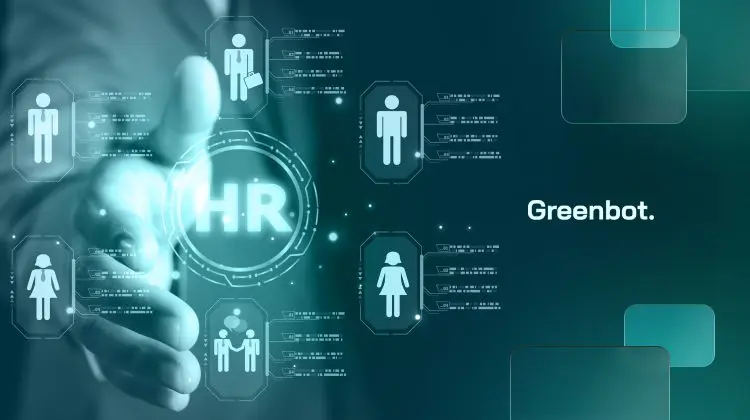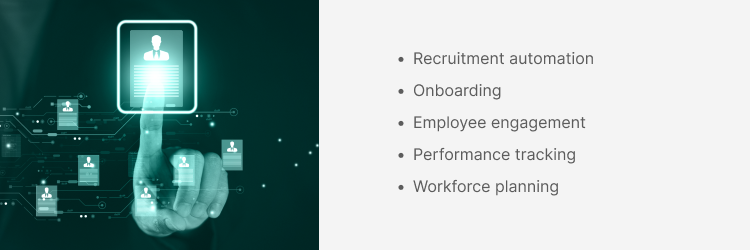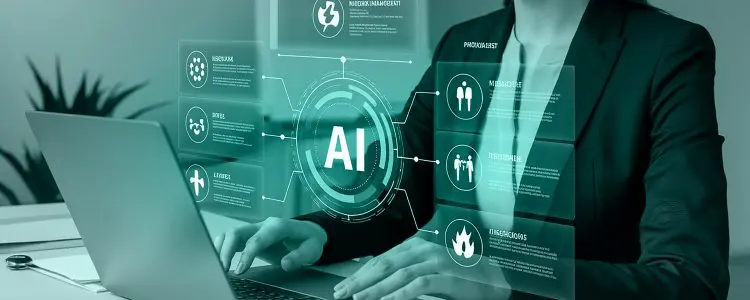
How AI is changing the future of human resources comes down to one thing: making HR smarter, faster, and less manual. From hiring to performance tracking, AI in HR is taking over routine tasks and giving HR professionals room to focus on strategy.
This article breaks down exactly how artificial intelligence is reshaping core HR functions, including recruitment, onboarding, engagement, and analytics. We’ll cover the top uses, tools worth knowing, the benefits, and the challenges of using AI in HR today.
The Real Impact of AI Across HR Functions

Artificial Intelligence is helping HR teams ditch the spreadsheets and focus on what matters. It replaces repetitive tasks with smart systems that save time and improve accuracy.
- Recruitment automation: AI scans resumes, scores applicants, and conducts screening chats. This cuts hiring time by as much as 75%.
- Onboarding: AI chatbots guide new hires, collect documents, and create custom training plans—no manual emails needed.
- Employee engagement: AI tools track sentiment from surveys and feedback. HR departments get real-time alerts to act before morale drops.
- Performance tracking: AI monitors productivity, flags issues early, and suggests improvements—turning feedback into action.
- Workforce planning: Predictive tools spot patterns in hiring, exits, and skill gaps. This helps plan ahead, not just react.
AI for human resource management doesn’t just speed things up—it improves how decisions are made. Every action is backed by data, not guesswork.
Where AI Is Making the Biggest Difference in HR
AI in human resources is changing how companies manage people, from the moment a resume arrives to long-term retention. These tools are improving efficiency across key HR processes by using real data, reducing human error, and making smarter decisions.
Below are the areas where AI technology delivers the most value.
Smarter Talent Acquisition and Recruitment
AI in talent acquisition makes the hiring process faster and sharper. Resume scanners filter thousands of applications in seconds, matching skills with job descriptions.
Predictive analytics help spot top candidates likely to succeed. Tools like HireVue and Pymetrics run tests and interviews that reduce bias in the recruitment process.
Leveraging AI in hiring improves quality, reduces time, and builds stronger teams from day one.
Automating Onboarding for New Hires
Onboarding often involves repetitive forms, questions, and emails. AI technology now handles most of it.
Virtual assistants like Talla or ChatGPT can answer FAQs, guide users through tasks, and automate welcome messages. This helps HR focus on relationships, not paperwork.
By automating administrative tasks, companies give new hires a smoother start in the employee life cycle.
Boosting Employee Engagement and Satisfaction
Employee engagement is key to retention. AI tools now collect real-time feedback and analyze how employees feel.
Platforms like CultureAmp and Peakon highlight issues before they grow. They help HR teams act faster and smarter.
The result? Higher employee satisfaction and fewer surprises in performance or morale.
Personalized Learning and Upskilling
AI in human resources also boosts learning and development. Platforms like LinkedIn Learning recommend content based on performance, goals, and job roles.
Employees see career development opportunities tied to their work. This supports employee development and keeps skills sharp in fast-changing industries.
Training sessions feel custom, not generic.
Performance Management and Retention at Scale
Tracking progress manually doesn’t work at scale. AI handles performance management with automated review cycles, real-time benchmarks, and improvement tips.
Tools like BambooHR and Workday use HR analytics to track employee performance and flag who might leave.
This data shapes better strategies for employee retention and coaching.
Strategic Workforce Planning with AI
Workforce planning is no longer guesswork. AI helps HR leaders forecast hiring needs, skill gaps, and team size with hard data.
Platforms like Visier and SAP SuccessFactors empower HR with data-driven decision-making. They pull from employee data and help shape strategic initiatives confidently.
Top AI Tools Transforming HR Today
Here are the AI tools commonly used across the HR industry today:
Recruitment and Hiring
- HireVue: Uses AI-driven video assessments to evaluate candidate skills and streamline the screening process.
- Eightfold.ai: Employs predictive analytics to recommend suitable candidates based on past hiring data.
- Pymetrics: Utilizes cognitive and emotional assessments to match candidates with roles that align with their strengths.
- HiredScore: Leverages AI to automate resume screening and rank candidates based on job fit.
Employee Engagement and Communication
- ChatGPT: Acts as a virtual assistant to answer common HR queries and provide onboarding support.
- Ultimate Software’s UltiPro: Tracks employee sentiment and engagement through AI-powered surveys and analytics.
Analytics and Workforce Planning
- IBM Watson: Offers advanced HR analytics for data-driven decision-making and predictive insights.
- Visier: Analyzes workforce data to optimize HR planning and identify trends in hiring and retention.
- Workday: Integrates AI for comprehensive HR analytics, from performance tracking to workforce forecasting.
- ADP DataCloud: Provides AI-driven workforce insights, helping HR teams predict performance outcomes and potential turnover.
Practical AI in Action: ChatGPT for HR Teams
ChatGPT is becoming a handy assistant for HR teams. It helps handle routine tasks quickly and clearly, freeing time for deeper work.
Need to create job listings? ChatGPT helps with writing job descriptions that are accurate, structured, and aligned with your hiring goals.
It also works well as a virtual assistant, answering employee FAQs like “When is payroll processed?” or “How do I update my benefits?” The answers are fast, consistent, and based on set data.
Scheduling interviews or internal meetings? ChatGPT helps draft emails, send reminders, or generate calendar invites—saving teams from juggling inboxes.
Because it uses natural language processing, the tool responds in a way that feels human, not robotic. That matters when you’re managing people-focused tasks.
It also supports training content, policy drafts, and performance review templates—without HR starting from scratch.
By reducing time spent on repetitive tasks, ChatGPT allows HR professionals to focus on real conversations rather than administrative work.
AI in HR: The Good, the Bad, and the Critical
The benefits of AI in HR are clear. It saves time, reduces paperwork, and offers personalization across the employee lifecycle. It speeds up hiring, tracks performance, and helps HR leaders spot problems before they escalate.
AI-powered tools also enable smart decisions using data. They learn over time through machine learning, making HR functions more responsive.
But there are concerns. One issue is bias. If the data used to train an AI solution is flawed, the results can be, too. This can affect fairness in hiring and evaluation.
Another risk is privacy. Collecting data across systems can lead to unclear ownership. Ethical considerations like transparency and consent are essential when adopting AI.
Still, AI adoption isn’t about replacing people. It’s about enabling HR teams to do more meaningful work.
To use AI wisely, leaders must maintain the human touch, checking how results are used and always keeping people at the center of HR management.
What’s Next: The Future of AI in Human Resources
The future of AI in HR looks more advanced, helpful, and personal.
Generative AI in HR will go beyond templates. It will help build onboarding paths, internal FAQs, and even engagement campaigns that adapt to each user.
Predictive analytics will play a bigger role in spotting burnout risks, promotion paths, or future hiring gaps. That means better planning and less reaction.
HR leaders will also need to focus on reskilling. As tools improve, the skillset to run them must grow too. Adopting AI means building comfort with data, tools, and change.
AI-driven chatbots will become more proactive, checking employee well-being, not just waiting for input.
To stay ahead, business leaders must match AI plays with a clear purpose. It’s not just about task automation; it’s about creating an enhanced employee experience while still delivering results.
The most innovative ways HR professionals can win are by implementing AI where it adds value and staying human where it matters most.
FAQs About AI in HR
How is AI being used in HR departments today?
HR professionals use AI-driven tools to handle recruiting, onboarding, training, and employee feedback. Common examples include resume screening, automated surveys, and predictive workforce planning. These are a few ways HR professionals apply AI to improve efficiency and reduce manual tasks.
Can AI in HR help reduce bias in hiring?
Yes—but only when it’s trained and applied correctly. Leveraging AI can reduce human bias by focusing on skills and job fit instead of personal traits. However, the AI tool may still reflect bias if the training data is flawed. It’s not perfect, but it helps make hiring more consistent.
What are the biggest challenges of AI in HR?
One major issue is data quality. If the data is limited or skewed, the results won’t be accurate. Another challenge is trust—integrating AI in sensitive areas like hiring or evaluation requires transparency. Many teams also face skills gaps when trying to use new tools effectively.
Will AI replace HR professionals in the future?
No. AI in HR is built to support—not replace—human roles. It takes over repetitive tasks, freeing HR professionals to focus on relationships and strategy. People still make the final decisions. AI tool adoption makes teams stronger, not smaller.
How does AI improve employee engagement?
AI-driven tools help track mood, feedback, and communication in real time. This lets teams spot issues early and act quickly. Key benefits AI brings to engagement include faster follow-up, more personal support, and better insight into how people really feel at work.
Conclusion
Artificial intelligence is no longer a buzzword in HR—it’s a practical game-changer. From streamlining time-consuming tasks to sharpening talent management, today’s AI systems are helping HR leaders rethink how they work.
With smart AI models, natural language processing, and machine learning tools now powering everyday HR functions, the future of HR practices is faster, sharper, and more human-focused.
If you’re in HR, it’s time to align your business strategy, embrace these tools, and lead the charge in transforming how modern HR processes get done.




















